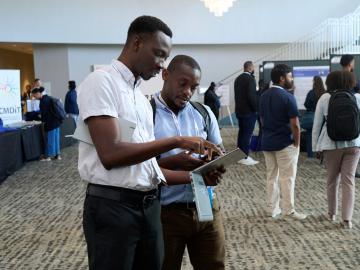
Filter News
Area of Research
News Topics
- (-) Big Data (78)
- 3-D Printing/Advanced Manufacturing (145)
- Advanced Reactors (40)
- Artificial Intelligence (127)
- Bioenergy (110)
- Biology (126)
- Biomedical (73)
- Biotechnology (37)
- Buildings (73)
- Chemical Sciences (84)
- Clean Water (32)
- Composites (34)
- Computer Science (224)
- Coronavirus (48)
- Critical Materials (29)
- Cybersecurity (35)
- Education (5)
- Element Discovery (1)
- Emergency (4)
- Energy Storage (114)
- Environment (217)
- Exascale Computing (65)
- Fossil Energy (8)
- Frontier (63)
- Fusion (65)
- Grid (74)
- High-Performance Computing (129)
- Hydropower (12)
- Irradiation (3)
- Isotopes (62)
- ITER (9)
- Machine Learning (67)
- Materials (156)
- Materials Science (156)
- Mathematics (12)
- Mercury (12)
- Microelectronics (4)
- Microscopy (56)
- Molten Salt (10)
- Nanotechnology (63)
- National Security (86)
- Neutron Science (169)
- Nuclear Energy (122)
- Partnerships (67)
- Physics (69)
- Polymers (35)
- Quantum Computing (53)
- Quantum Science (91)
- Security (31)
- Simulation (64)
- Software (1)
- Space Exploration (26)
- Statistics (4)
- Summit (70)
- Transportation (102)
Media Contacts

Analyzing massive datasets from nuclear physics experiments can take hours or days to process, but researchers are working to radically reduce that time to mere seconds using special software being developed at the Department of Energy’s Lawrence Berkeley and Oak Ridge national laboratories.
Daniel Jacobson, distinguished research scientist in the Biosciences Division at ORNL, has been elected a Fellow of the American Institute for Medical and Biological Engineering, or AIMBE, for his achievements in computational biology.
Dave Weston studies how microorganisms influence plant health and stress tolerance, using the Advanced Plant Phenotyping Laboratory to accelerate research on plant-microbe interactions and develop resilient crops for advanced fuels, chemicals and

Not only did ORNL take home top honors at the 2024 International Conference for High Performance Computing, Networking, Storage, and Analysis (SC24), but the lab’s computing staff also shared career advice and expertise with students eager to enter the world of supercomputing.

Phong Le is a computational hydrologist at ORNL who is putting his skills in hydrology, numerical modeling, machine learning and high-performance computing to work quantifying water-related risks for humans and the environment.

Scientists conducted a groundbreaking study on the genetic data of over half a million U.S. veterans, using tools from the Oak Ridge National Laboratory to analyze 2,068 traits from the Million Veteran Program.

The National Center for Computational Sciences, located at the Department of Energy’s Oak Ridge National Laboratory, made a strong showing at computing conferences this fall. Staff from across the center participated in numerous workshops and invited speaking engagements.

Scientists and land managers interested in accessing the first dataset of its kind on one of the most biologically diverse ecosystems in the world were given hands-on tutorials during a recent workshop by researchers supporting the ORNL Distributed Active Archive Center for Biogeochemical Dynamics.


Scientists at the Department of Energy’s Oak Ridge National Laboratory recently demonstrated an autonomous robotic field monitoring, sampling and data-gathering system that could accelerate understanding of interactions among plants, soil and the environment.


